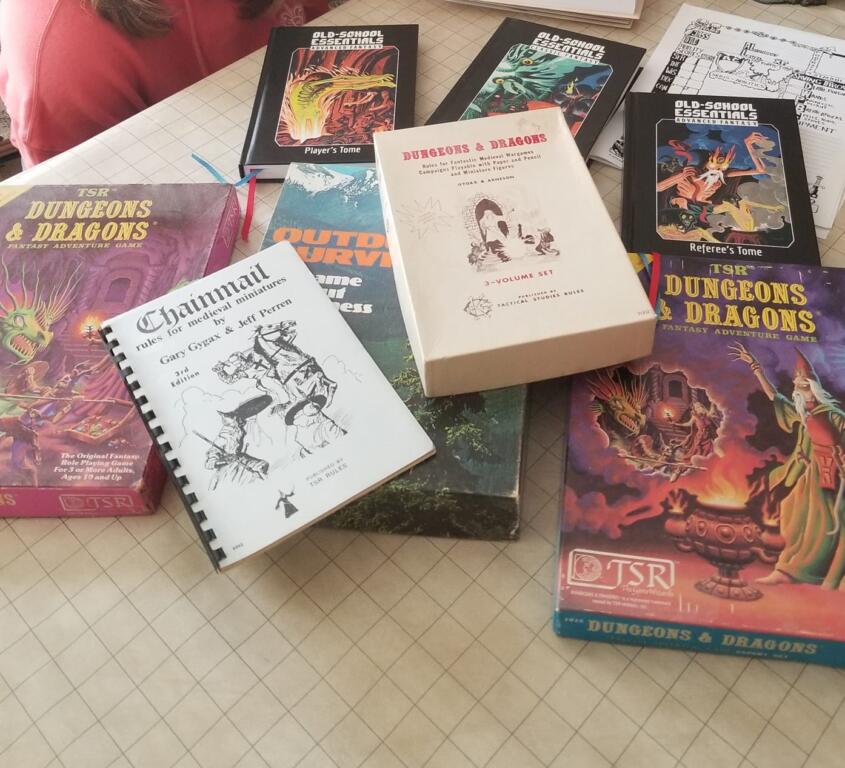I wanna go back and do it all over but I can’t go back, I know.
— Eddie Money, “I Wanna Go Back”
Can you make what’s old new again?
Hi, all! It’s been seven years since this Original Gnome has been a regular contributor and six years since I’ve produced anything for the Stew. So why have I finally gotten out of the rocking chair and off the porch? Well, because I’ve finally found new things to say about, well, old things!
Specifically, I’ve spent much of my gaming time this year running Old School Essentials (OSE), which is essentially a repackaging of what is commonly known as the B/X edition (1981) of Dungeons & Dragons, and I thought I’d share some of my insights!
How it Began
This journey started when I was watching a YouTube video last year by Matt Colville and my eldest daughter said that old school dungeon delving sounded like a lot of fun. I decided that I’d show her how we used to play by putting together a group and playing like it was the early 1980s.
I also printed her a copy of A Quick Primer for Old School Gaming and shared it with the budding group before play, as well as took a look at the notes for the West Marches campaign, which, like I was hoping to do now, emulated that 1970s playstyle.
But then a funny thing happened on the way to the Wayback Machine. I realized that, despite owning and playing the B/X edition (my first roleplaying game), I’d never actually played in the Old School style. If I was going to pull this off, I had a lot of learning and adapting to do!
Disclaimer
Before continuing, I feel that I should point out that I am not claiming any familiarity with the way Dungeons & Dragons was originally intended to be played nor am I familiar with the Old School Renaissance/Revival/Rules movement (OSR) beyond playing a big game of catch-up this year.
Nor am I claiming that I am playing OSE exactly the way Gary Gygax’s group did in the 70s or even the way Tom Moldvay intended in 1981. This series of articles is my interpretation and implementation of old concepts for my gaming group.
The First Lesson: Defining a Campaign
While the ruleset I’m using is a restatement of the B/X rulebooks and written by someone other than Gary Gygax or Dave Arneson, there is a lot of terminology and assumptions regarding familiarity that simply went over my head as a kid (which I later cheekily termed “High Gygaxian,” although I’m sure that I’m far from the first!) and only now, decades later, do I better understand what was being conveyed in many of those Dungeons & Dragons and Advanced Dungeons & Dragons books.
But let’s step back a minute. As a forever Game Master (my preferred title), I’m used to thinking about my games in terms of sessions, adventures, and campaigns. “Sessions” is by far the easiest to define, as it is the time that the group gathers (physically or virtually) to play. It doesn’t matter what happens during that period; being together is a session.
An “adventure” is the journey to complete a shared objective. This could take one session, multiple sessions, or even just part of a session. As long as the player characters are given a goal and they go about completing it, overcoming the challenges along the way, that’s an adventure.
It’s “campaign,” that I sometimes struggle to fully define (I often resort to US Supreme Court Justice Potter Stewart’s description of obscenity when defining a campaign: “I know it when I see it”). When I come across a GM that proudly proclaims that they’ve been running the same campaign for 20 or 30 years, I just can’t comprehend it. Three decades? With the same characters? With the same storyline?
To me, a “campaign” is a series of linked adventures that builds to a hopefully exciting conclusion. The final adventure in a campaign might be having the now-powerful PCs taking on the Big Bad of the campaign, or it may simply be the last adventure that these PCs have before walking off into the sunset. Usually, a campaign has roughly the same cast of PCs at the end as at the beginning, but sometimes PC turnover can lead to a completely different cast finishing the campaign.
But while preparing for my OSE campaign, I realized that I needed to replace these definitions.
Old School Definitions
In the Old School (at least as I recognize it, see the above disclaimer!), there is no concept of a “session.” Everything is defined as an “adventure” or a “campaign.” To take the latter first, a “campaign” is merely the playing area that the GM (or Referee or Dungeon Master) prepares for the group to go adventuring in.
When Old School players speak of exploring the world, they really mean this map. Thus, the “world” can be as small as a single town and nearby dungeon, or as large as an entire world (and beyond!). It’s really up to the GM how much they want to create. But whatever they design, Old School players want to feel free to roam all over it at their discretion.
For them, an “adventure” means the same thing as a “session.” It is understood that the session begins with the group gathered at a home base (usually a town or a keep out on the borderlands). The group decides where they want to explore, they spend the bulk of the session doing it, and at the conclusion of the session they return to their home base to bank treasure, learn about magic items, gain XP, and potentially level up.
Since the group probably doesn’t explore an entire dungeon in a single adventure/session, the terminology can be a bit confusing to modern minds. Cleaning out, for example, the Tunnels of Terror, might take several adventures. It’s also possible that the group might move on to explore the Caldera of Doom before finishing the Tunnels.
One Last Point about Campaigns
I stated above that the campaign is simply the area that a GM has prepared. While that is true, there is a bit more to it in the Old School. The GM’s world is a “living” place, and any group of players that plays with that GM is assumed to be playing in the same campaign.
So, you could literally have a situation that a group that meets on Sundays may be exploring the Tunnels of Terror, only to find one Sunday that a group that met on Wednesday finished cleaning it out. It’s even possible that some of the same Sunday players and characters might have been in the Wednesday group.
This is the thinking behind Gary Gygax’s infamous line in the 1979 Dungeon Master’s Guide, “YOU CAN NOT HAVE A MEANINGFUL CAMPAIGN IF STRICT TIME RECORDS ARE NOT KEPT” (emphasis his). As Mr. Gygax was running several groups through his campaign at once, he needed to keep track of where all the characters were at any given time. He assumed that all other GMs would be blessed with the number of players, and opportunities to play, that he had.
Wrapping Up
Having educated myself on the terminology, I knew I couldn’t fully embrace them. My campaign was going to take place at a set time (about once a month) and whoever showed up that day would go on an adventure. The group would start in a safe place and end in a safe place.
As a nice bonus, this meant that there wouldn’t be a need to worry about missing players. Anyone who couldn’t make the session simply didn’t join the party for that adventure, and it also allowed present players to swap out characters if they wanted to.
On the potential downside, I also needed to get the PCs back to a safe place at the conclusion of each adventure. This meant that I’d sometimes have to handwave things to ensure that happened, no matter where the group found itself by the session’s final hour.
Hopefully, you found this discussion as insightful as I did! Next time, I’m going to talk about setting up my Old School campaign!


















This is great – I’m looking forward to your next article!
I’m currently in the middle of setting up an OSE game for my kids and some friends, so this is relatable for me.
When I ran a campaign like this, the hand-waving was popping characters in and out of other adventures. I didn’t worry about everyone getting back to home base. Five people went in one adventure and only two showed up next time? Those two get a short one-session adventure, mysteriously popping out of the previous session and coming back for the next. That way, I could run longer expeditions into the adventure area. Also, I only had enough people for one party.
So what was the explanation for how people disappeared and reappeared? I never had to create one. If the campaign had gone on long enough, I’m sure I would have been able to concoct one from the speculation of the players.